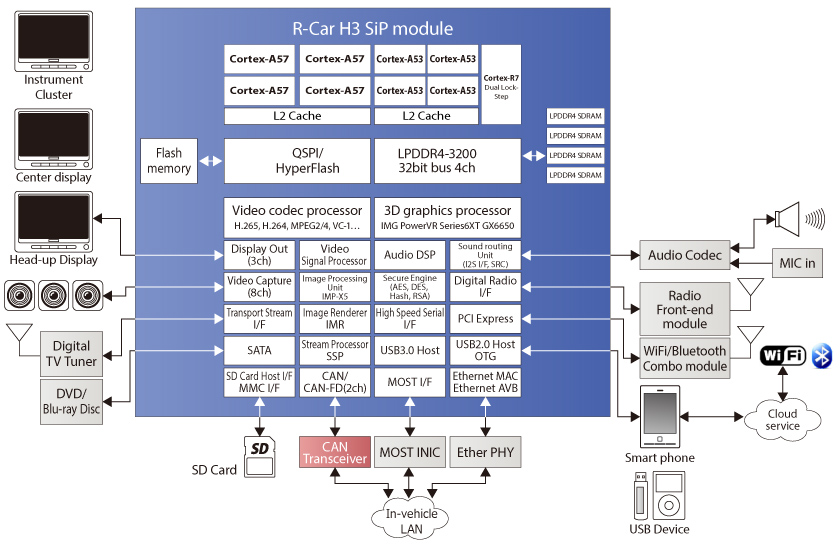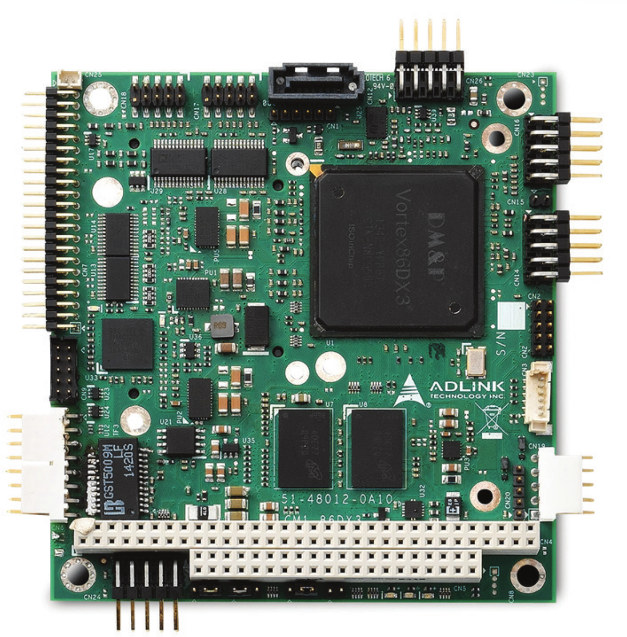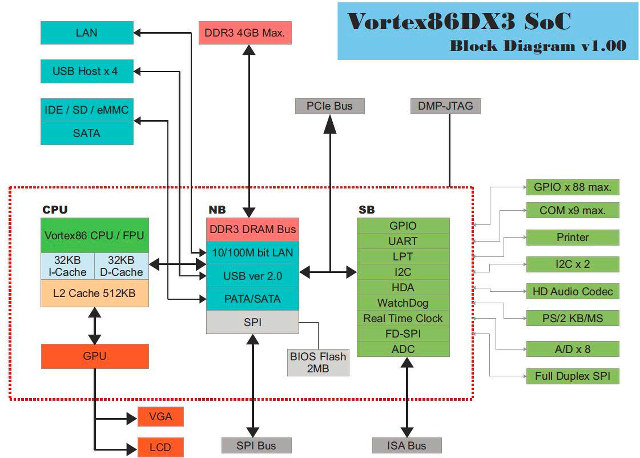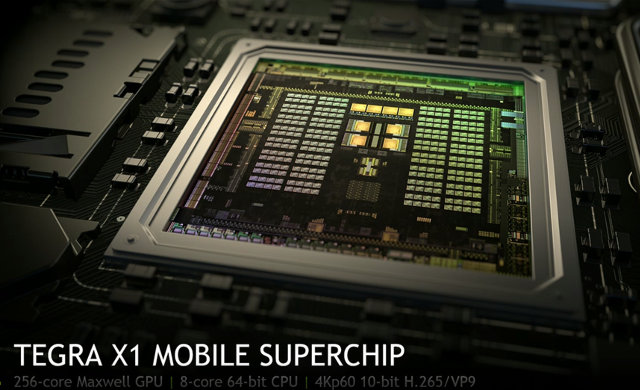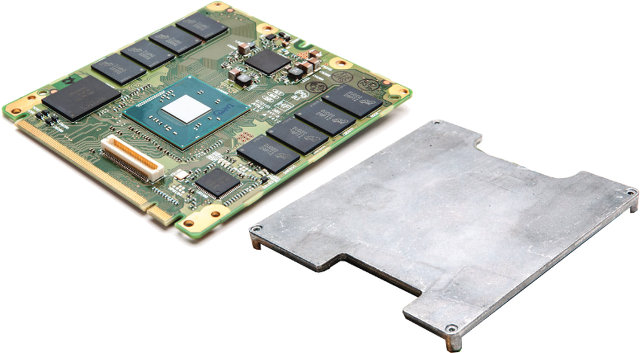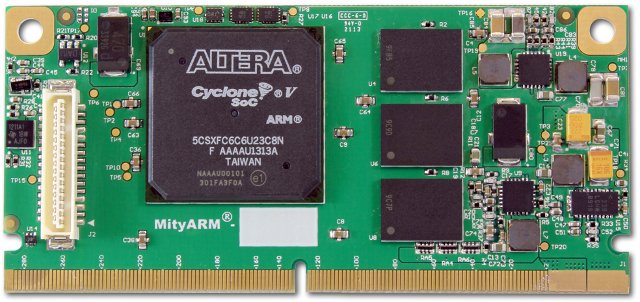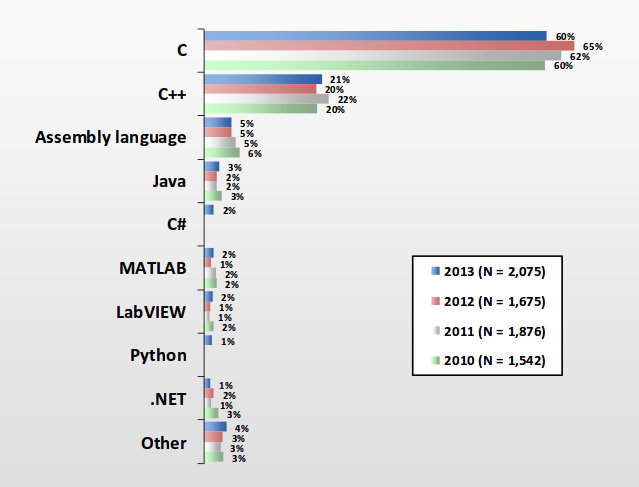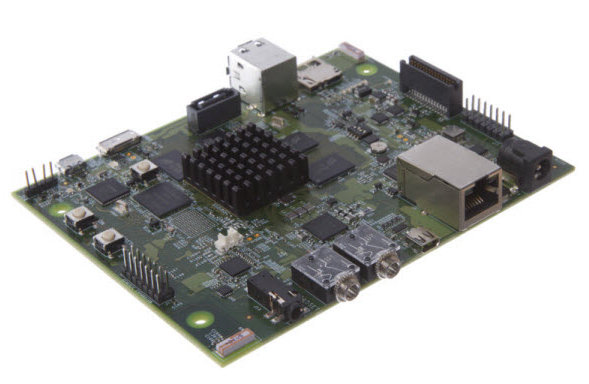Renesas has recently unveiled R-Car H3 deca-core processor for automotive applications with four Cortex A57 cores, four Cortex A5 cores, and two Cortex-R7 “dual-lock step” cores for real-time processor, and has part the releases showed the expected roadmap for the implementation of driverless / autonomous cars. Let’s start with the processor (R8A77950) and SiP module (R8J77950) specifications: CPU cores – quad core ARM Cortex-A57, quad core ARM Cortex-A53, and dual lock-step ARM Cortex-R7 cores with respectively 48KB/32KB, 32KB/32KB, and 32KB/32KB L1 instructions/operand cache. GPU – IMG PowerVR Series6XT GX6650 External memory – LPDDR4-SDRAM up to 1600 MHz, data bus width: 32 bits x 4 ch (12.8GB/s x 4) Expansion bus – 2 ch PCI Express2.0 (1 lane) Video Out – 3x display output Input / camera – 8x video inputs Video codec module (H.265, H.264/AVC, MPEG-4, VC-1, etc.) IP conversion module 2x TS Interfaces Stream and Security Processor Video image […]
ADLINK CM1-86DX3 Dual Core Vortex86DX3 SBC Complies with PC/104 Standard
Adlink has recently introduced a rugged industrial single board computer based on PC/104 standard with anISA bus, and powered by DM&P Vortex86DX3 dual core processor combined with 2GB RAM, SATA and CFast for storage, and Fast & Gigabit Ethernet for networking. Adllink CM1-86DX3 board specifications: SoC – DM&P Vortex86DX3 dual core x86 processor @ 1GHz with 2D GPU, FPU, 32K I-Cache, 32K D-Cache, and 512KB L2 Cache Memory – 2GB DDR3L Storage – SATA, CFast socket. Video Output – VGA; 18/24-bit single-channel TLL/LVDS Connectivity – 1x integrated Fast Ethernet, 1x Gigabit Ethernet (via Intel i210T) USB – 2x USB 2.0 Serial – 2x RS232/422/485,2x RS232, Other I/Os -8x GPIO, 8x A/D Misc – RTC; watchdog; PS/2 port; Smart Embedded Management Agent (SEMA) functions such as a timer, temperature. monitor, fail-safe BIOS, etc… Power Supply – 5V DC (AT mode); Consumption: ~6-7 W Dimensions – 96 x 90mm (PC/104 specifications 2.6 […]
Vortex86DX3 is a New x86 SoC for Embedded Systems
Intel is already making embedded version of their processor with example with Bay Trail-I or Quark SoCs, but Taiwan based DMP Electronics has also been making x86 SoC such as Vortex86EX that can be found in $39 86duino Zero board, which must be one the cheapest, if not the cheapest, x86 board on the market. Of course, this is not designed to run Windows and Office, but rather some embedded (IoT) applications. The company has recently launched Vortex86DX3, a more powerful x86 dual core processor, suited to embedded systems and communication products such as thin clients, NAT routers, gateways, etc… DMP Vortex86DX3 specifications: Dual Core x86 Processor @ 1GHz with 6 stage pipeline, x86 instruction set Floating point – Implements ANSI/IEEE standard 754-1985 for binary Floating-Point Architecture Cache – 8-way 32K I-Cache, 8-way 32K D-Cache, 4-way 512KB L2 Cache with write through or write back policy System DDR3 Control Interface – 32-bit data […]
Nvidia Announces Tegra X1 64-bit Octa-core Processor with 256-Core Maxwell GPU
CES 2015 has started, and the first company to present their innovations is Nvidia. Last year their introduced Tegra K1, the first mobile processor with a desktop GPU with support for OpenGL. They’ve now raised the bar with Tegra X1, an octa-core 64-bit ARM processor with a 256-core Maxwell GPU delivering 1.5x to 2x the performance of Tegra K1, and supporting 4K60 video playaback with H.265 and VP9 codecs. Some geekbench benchmark comparing X1, K1, and Apple A8x. Nvidia CEO also claiemd Tegra X1 is the first mobie SoC delivering over 1 Teraflops, something that was achieved around year 2,000 with 20,000 Pentium pro processor consuming 1 millions Watts, while X1 SoC only consumes about 10 Watts. Power efficiency is said to have improved too, as Maxwell GPU is said to delivers more performance with similar power efficiency. They also introduced Drive CX mini computer for automotive application featuring Tegra […]
Intel Unveils In-Vehicle Solutions and Development Kit for Assisted Driving and Autonomous Cars
Intel has announced their In-Vehicle Solutions (IIVS) for automakers comprised of hardware based on Intel’s industrial Bay Trail Atom 3800 series SoC, and software solutions relying on a Linux based operating system but it’s not clear whether it might be Wind River Linux, Tizen IVI, or another new OS. The solutions will first provide In Vehicle Infotainment (IVI) with assisted driving features such as , and over time it will allow semi-autonomous and self-driving cards. At the heart of the system, Intel will provide CM1050 computer-on-module that will be part of a development kit including a chassis with CAN, Ethernet, and USB ports, as well as audio and CVBS multimedia I/Os, and radios and antennas for FM, AM, DAB, GPS, WiFi, Bluetooth, and cellular. A Blu-ray drive, and SSDs will be available as storage options. The complete system is designed to be upgradeable, and automakers can expected modules with faster […]
Critical Link MityARM-5CSX CoM Powered by Altera Cyclone V SoC
Earlier this week, I wrote about EnSilica eSi-ZM1, a system-on-module based on Xilinx Zynq7000 Extensible Processing Platform that comes with a dual core ARM Cortex A9 and FPGA fabric. It turns out Xilinx is not the only game in town, and Altera’s Cyclone V SoC, announced last December, also includes a dual core ARM Cortex A9 processor with Altera FPGA logic, and Critical Linux recently announced MityARM-5CSX computer-on-module based on this platform. Target applications include machine vision, scientific imaging, motor control, medical imaging and instrumentation, test and measurement, industrial instrumentation, as well as a military & aerospace. MityARM-5CSX specifications: SoC – Altera Cyclone V SX-U672 with FPGA logic and dual-core ARM Cortex-A9 up to 800MHz System Memory – 1GB DDR3 RAM, and 256MB DDR3 FPGA RAM (optional) Storage – 32MB QPSI NOR flash FPGA I/O fabric: PCIe hard core Up to 145 user-programmable I/O lines (including several 875MHz SerDes lanes) […]
2013 Embedded Market Study – Software Development & Processors
UBM releases a study of the embedded market every year, by surveying over 1,000 embedded professional every year. They’ve just published their 2013 Embedded Market Study (85 pages report), after surveying over 2,000 engineers and managers, so let’s see whether anything has evolved in the software development and processor space compared to 2012. Again this year, most respondents are based in the US (62%), followed by Europe (20%), and Asia (12%). C/C++ languages still rule the embedded world with 81% market share, although a little less than last year (85%), assembler is a distant third (5%). Interestingly, the average size of development teams seems to have shrunk from 15.9 in 2012 to 14.6 in 2013, the average project being composed of 4 software engineers, 2.9 hardware engineers, 2.7 firmware engineers, 2 QA/Test engineers, 1.5 system integrators, and 1.5 with other functions. About a third of project last less than 6 […]
$329 Texas Instruments OMAP5432 EVM / Development Board
Earlier this month, Texas Instruments has apparently discreetly, not to say surreptitiously, launched their OMAP5432 evaluation module. Beside the dual Cortex A15, dual Cortex M4 OMAP5 SoC, the board comes with 2GB RAM, a 4GB eMMC module, USB 3.0, SATA and more. OMAP5432 EVM Specifications: SoC – Texas Instruments OMAP5432 Multicore ARM Cortex A15/M4 processor with PowerVR SGX544MP2 GPU System Memory – 2GB DDR3L (implemented using 4x Micron 4Gb DDR3L devices (MT41K256M16HA-125:E) Storage – 4GB EMMC/iNAND Ultra device + SD/MMC 4-bit Micro-SD card cage Display / Video: HDMI via native OMAP HDMI interface DSI Display Expansion (DSIPORTA and DSIPORTC) via 100-pin expansion connector Parallel Display Expansion (DPI) via 100-pin expansion connector Audio – Audio Jack 3.5mm, Stereo out & in, Headset Jack (earphone/microphone) USB – 3x USB HS 2.0 (2 via USB connector, one via 0.1″ header), 1x USB 3.0, and 1x USB OTG 2.0/3.0 Connectivity – 10/100 802.3u Ethernet. […]


